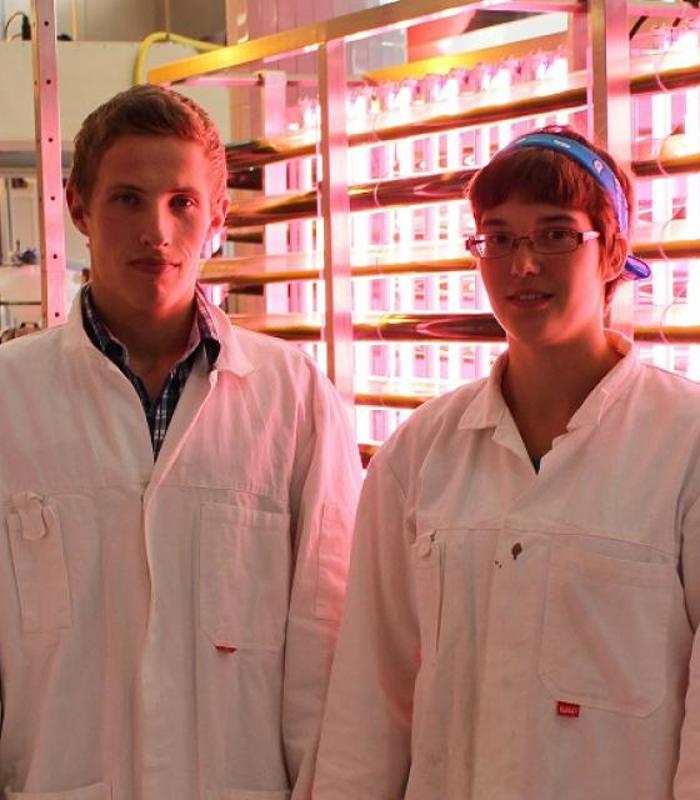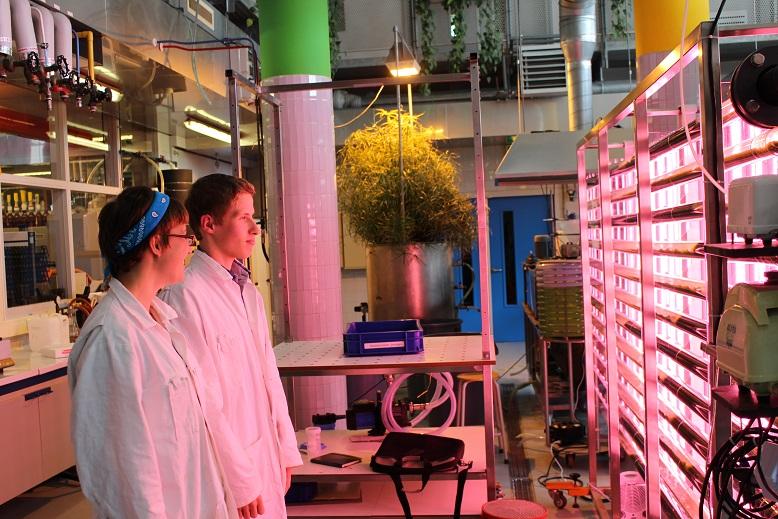Algae are organisms that make use of photosynthesis for the production of energy. They are used for the production of biodiesel, but they also produce nutrients that are healthy for humans and animals. Freeze-dried green algae are high in proteins and amino acids. They are sold all over the world as a food supplement in the form of algae powder.
Production of micro algae
The latter application is commercially the most interesting, and in that market LGem is a major player. LGem is the first Dutch company that manufactures microalgae on a commercial scale by using algae reactors. Much research is being done at LGem to improve the cultivation process in the algae reactors. One of those algae reactors has been made available to HAS University of Applied Sciences by LGem. Environmental Studies students Rick Cox and Katrijn Klok used it to examine the commercial viability of LED lighting for algae cultivation.
LED lighting for algae cultivation
“Horticulture is already experimenting a lot with LED lighting,” Katrijn says. “A combination of red, blue and far-red LED light turns out to be sufficient for plants to grow. Indeed, specific LED lighting is often more effective for the growth process than ordinary light.” Because algae, just like plants, use photosynthesis to grow, Katrijn and Rick examined the effect of LED lighting in algae reactors in an assignment for LGem. Normally, these reactors are lit by fluorescent lamps. These are supposedly less effective in terms of yield; however, they are a lot cheaper to purchase. The students therefore not only looked at the yields, but also at the financial returns of the investment.
Commercial viability
Katrijn: “We performed 6 ‘runs’ of 2 weeks each for our research, alternating between a run with LED lighting and a run with fluorescent lighting. Because commercial viability was also important, we started out with the same electricity input for both types of lighting. This resulted in a test with 24 LED lamps versus 12 fluorescent lamps.” The test results indeed showed that the algae grow faster with LED lighting than fluorescent lighting. However, the returns were not high enough to recoup the investment in LED lighting. “LED lighting does have a longer lifespan, but once the lamps need replacing, the costs are much higher than for fluorescent lighting,” Katrijn explains.
Follow-up research
The research into LED lighting was a follow-up of a previous professional assignment: an investigation into possible energy savings by letting the algae in the algae reactor run through the system in different ways. HAS lecturer Joep van der Helm: “We already achieved good results then in terms of energy savings while maintaining the desired growth rate.” The current research went well after the launch phase. “The students were not familiar with growing living organisms,” Joep says. “But with the support of Ellen Weerman and Judith van Eijck of Applied Biology and Herman Jillissen of Environmental Studies they energetically went to work and continually improved their working methods.”
Great connection between theory and practice
Joep considered it an educational professional assignment with a great connection between theory and practice. “That is exactly what HAS and the Environmental Science study programme are good at. The students were able to bring their own passions and talents into the project and apply the practical experience gained from their study programme and traineeships. Having executed the project very independently, they have laid a good foundation for further studies or a job.”


